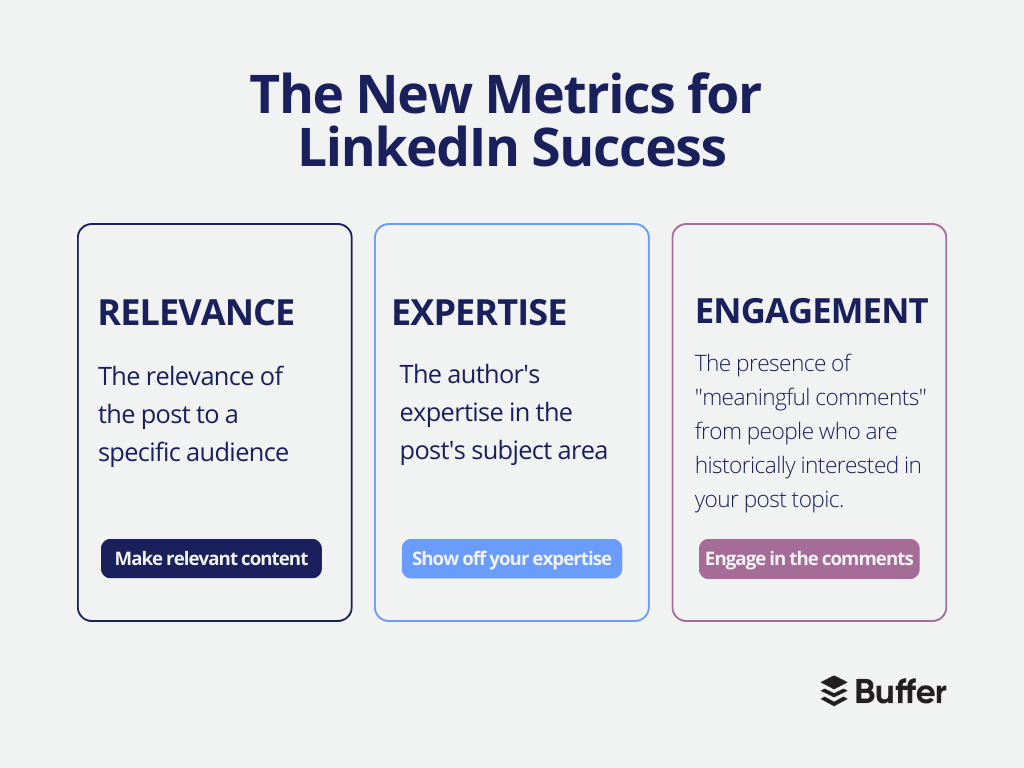LinkedIn’s algorithm has always been a bit of a mystery – until now. The algorithm recently underwent some key changes, and the team (through Dan Roth, editor-in-chief, and Alice Xiong, a product management director) sat down with Entrepreneur to explain them.
In this article, we’ll highlight the key points from the team’s interview about the LinkedIn algorithm and share practical tips for applying this knowledge to your content.
Understanding the LinkedIn Algorithm
Unlike YouTube and Instagram, LinkedIn feeds you content primarily from one place – your Feed. When you type in the LinkedIn URL, this is the landing page, so it’s your first impression of all the content on the platform.
With over 900 million members and the number of daily posts in the millions, if not billions, there’s no way around it: relevant content is key.
The promise of the algorithm is that if you create content relevant to a specific audience, they will see your content. The reverse is true for audiences: what they engage with is what they’ll see.
If you always engage with marketing-related content, you’ll see more of that on your Feed. If you always post about marketing, your target audience will inevitably see more of your content. And the more niche your approach is, the better the algorithm can direct your content to the top of the right Feeds.
With this context in mind, all the updates are in service of getting the right content in front of the right audience.
Virality is not a factor in the algorithm
Before, LinkedIn’s algorithm amplified the most engaging (viral) content. When work and personal lives merged a few years ago, the platform saw an influx of personal content reminiscent of what you’d see on Facebook.
With the change in posting style, membership and engagement grew, but also caused a lot of irrelevant content to float to the top of users’ Feeds. So with the algorithm updates, viral content is more likely to hurt your visibility and engagement than help it, as it might start hitting Feeds where it isn’t relevant, so not getting much engagement beyond reactions.
Your connections and followers will now see your posts first
This is a user-requested update, as most people find the content from their existing network the most valuable. This also means that the quality of your network is more important than ever – if you want engagement, the people you connect with need to see value in your content.
LinkedIn's updated algorithm rewards knowledge-rich posts by extending their reach beyond its immediate network. This indicates that even non-connected users who might find your content useful could see your posts.
LinkedIn will highlight more expert content
The platform is looking to highlight more knowledge and advice experts share. For users, the algorithm determines what expertise is relevant by identifying a user’s interests based on their profile info and activity.
For creators, it looks at the level of engagement and shares your content receives as a signal that you’re making something people want to see. Comments, especially in-depth replies, and continuing conversations, also help to improve your placement in the algorithm. Take advantage of LinkedIn’s features, like carousels or in-Feed videos, to add more detail to your posts.
The new metrics for success on LinkedIn
The new LinkedIn system uses certain metrics to evaluate content: Relevance, Expertise, and Engagement.
- Relevance: The relevance of the post to a distinct audience
- Expertise: The author's expertise in the post's subject area
- Engagement: The presence of “meaningful comments” from people historically interested in your post topic.

As a creator, you should aim to design content that not only appeals to a specific audience but also underscores your expertise and encourages genuine engagement. Here’s how.
What you need to do as a LinkedIn creator
You need to start treating LinkedIn like you would a work conference. You’re there to:
- give a keynote presentation (share expert content) and
- network with people (engage and make new connections)
So your presentation should:
- be relevant to the conference and its attendees (your niche and audience) and
- provide as much value to your audience in the time you’re allotted (the three seconds you have to stop someone from scrolling)
LinkedIn wants to: serve the right content to the right audience, which means categorizing content better. With this in mind, your posts will be categorized better if they:
- Share a unique perspective on a popular topic
- Show off your expertise with practical examples and advice
- Are easy to read
- Encourage responses with CTAs (“comment below if…”)
- Use three or fewer hashtags
- Incorporate keywords from the topic niche (check out tools for finding these keywords here)
- Tag people, especially if they post about similar topics, and can engage and add further insights.
More broadly, when creating these posts, you should:
- Focus on sharing knowledge and advice: LinkedIn’s algorithm update shows a return to form for the professional network. Take the opportunity to share more about the specific and maybe even mundane things that happen in your job with your network. Anything that comes from personal experience in your career and gives advice at the end will win in the new algorithm.
- Prioritize relevance over virality: Your content should share insights that can resonate with a specific professional audience instead of trying to appeal to a mass audience. If your passion is kitchens in Middle Eastern architecture and that’s what you choose to write about, the algorithm will make sure the right people see it.
- Your followers matter more than ever, but in quality over quantity: In the simplest terms, if you post about a topic, the people who will see it are those you follow or vice versa, then anyone interested in that topic. So, your LinkedIn network needs to be filled with people likely interested in what you share and will engage.
Finally, the more you share, the better LinkedIn will theoretically understand who you are, what you do, and who wants to see your posts, so publish frequently.
Great news, your niche interests, and knowledge are in demand
The updates to LinkedIn’s algorithm mean great things for creators with niche interests and expertise but aren’t sure how they’ll be received by a general audience. You don’t need to try to beat it or game it – just go with its flow.
Since the algorithm cares more about getting your content in front of the right people, you can be assured that you’ll grow as long as you optimize your posts and keep up your engagement through comments and replies.
In other great news, scheduling content isn’t penalized – only abandoning your scheduled content. So get a head start on drafting a bunch of new, relevant content for your audience on LinkedIn through Buffer.

